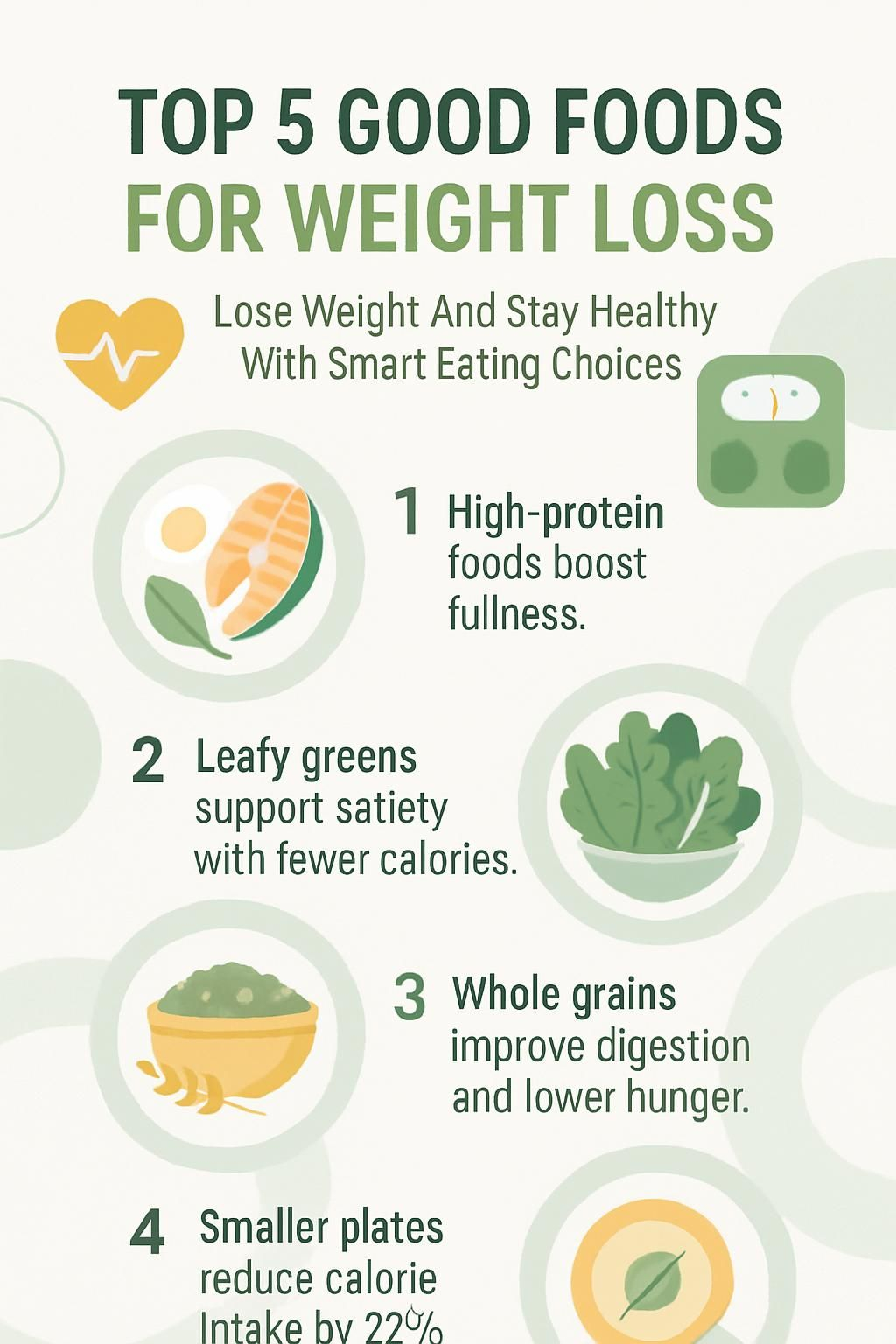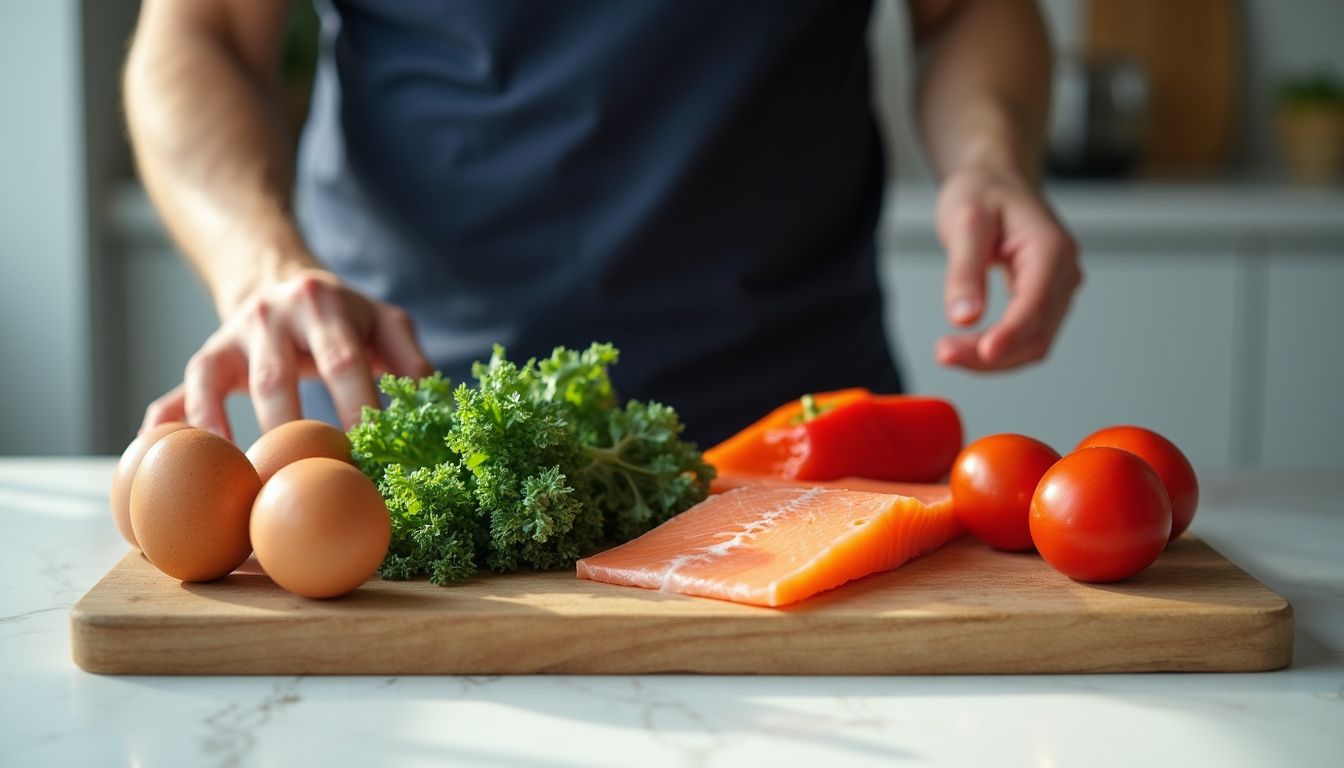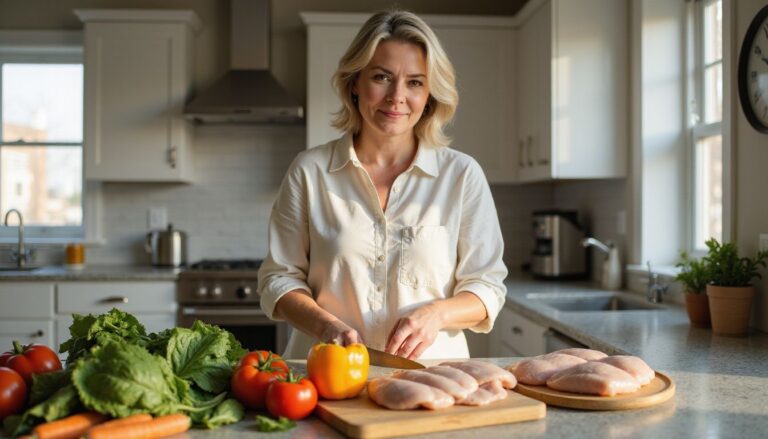Top 5 Good Foods For Weight Loss: Lose Weight And Stay Healthy With Smart Eating Choices
Our Nutrition Assistant AI Suite will transform your body. You will lose fat, get toned, and build muscle. Gain confidence and optimal health.
If you want to lose weight but feel stuck, you are in good company. Choosing healthy foods that help you feel full on fewer calories can change your day. Eggs, leafy greens, fish, and other simple staples can help you lose weight without feeling deprived.
In this guide, you will see which foods may help you lose weight and how to use them with smart, steady habits. Expect clear steps, easy swaps, and ideas you can start today.
Key Takeaways
- High protein foods like eggs, chicken breast, and fish promote fullness and protect muscle during weight loss, as reported by Mayo Clinic Diet resources.
- Leafy greens and cruciferous vegetables such as spinach and broccoli are rich in fiber, vitamins, and water; they fill you up with fewer calories.
- Whole grains have more protein and fiber than refined grains; research links them with better digestion, lower hunger, and long-term weight control.
- Using smaller plates supports portion control and can cut calorie intake by up to 22 percent, based on a 2014 meta-analysis in the American Journal of Clinical Nutrition.
- Combining smart food choices with at least 150 minutes of moderate exercise each week supports lasting weight-loss results, according to CDC guidance and findings in the Journal of Obesity.

Why Are Smart Eating Choices Crucial for Weight Loss?

Healthy eating sits at the center of any successful weight loss plan. Weight loss happens when you eat fewer calories than your body uses. The Mayo Clinic Diet highlights energy density, which means calories per bite. Foods high in water and fiber, like fruits and vegetables, help you feel full with fewer calories.
Choose low-calorie, nutrient-dense foods so you do not feel deprived. Picking whole grains instead of refined grains can keep you satisfied longer because of fiber. Professional guidance can also reduce guilt or extreme restriction, both of which may lead to disordered eating. I had trouble with portion size at first, but shifting to protein and fiber-rich meals lowered my urge to snack at night.
A caloric deficit is required for weight loss, consume fewer calories than expended.
If you struggle with eating patterns or mood around food, contact the National Alliance for Eating Disorders or the SAMHSA helpline at 1-800-662-4357. Getting support is a strong step toward a healthy weight.
Each smart choice on your plate builds habits that last. Small changes add up over time.
How Does Nutrition Affect Weight Management?
Food is fuel for your body and your daily routine. Calories come from carbohydrates, protein, and fat. Balancing these nutrients helps you manage hunger and energy.
Protein from lean meats, eggs, fish, beans, and low-fat dairy raises satiety. Feeling full helps you stick to healthy eating patterns. Weight loss also needs a calorie deficit, which means eating less energy than you burn.
Choose wholesome options. Whole grains, like oats, brown rice, and quinoa, support long-term success in systematic reviews. Healthy fats in avocados and nuts can help control appetite hormones and support heart health, based on American Heart Association guidance.
A 2022 study in adults with type 2 diabetes found that high fiber diets using legumes or chia seeds reduced body fat over time more than lower fiber plans. Fruits and vegetables with high water content add volume with very few calories. Fiber slows digestion and tamps down between-meal hunger. This helps you avoid yo-yo plans and quick fixes.
Top Foods to Support Effective Weight Loss
Foods that are high in protein or fiber, yet low in calories, can make weight loss simpler. The choices below work in many meals and taste great.
What Are the Benefits of Eating Eggs for Weight Loss?
Eggs are nutrient-dense, portable, and budget-friendly. They deliver high quality protein and healthy fat, which fits breakfast or any meal.
In a 2020 study, adults who ate eggs with toast in the morning felt fuller longer than those who ate cereal with milk and juice. That led to fewer calories later in the day. Another study with 48 people found that egg protein paired with fiber boosted fullness more than low fiber breakfasts.
When I replaced sugary cereal with eggs, I had fewer mid-morning cravings and steadier energy.
Eating eggs for breakfast keeps me satisfied until lunchtime.
Eggs offer rich nutrition for few calories, which supports sustainable weight-loss habits.
Why Should You Include Leafy Greens in Your Diet?
Kale, spinach, and collard greens deliver fiber, vitamins, and minerals for very few calories. They supply iron, calcium, magnesium, potassium, and vitamin K. Their high water content also supports hydration. The Academy of Nutrition and Dietetics notes that hydration aids healthy weight control.
Leafy greens contain thylakoids, plant compounds that may help manage appetite. Large portions add bulk to meals without many calories or saturated fat. Sauté greens or build salads with spinach. Pair them with fish like salmon for a balanced plate that helps you stay full.
How Does Fish Help With Weight Loss?
Fish gives you lean protein with fewer calories, plus healthy fats that help you feel satisfied. Oily fish, such as salmon, sardines, and mackerel, provide omega-3 fatty acids. Omega-3s support satiety hormones and heart health.
Eating fish twice a week also boosts iodine intake, which supports the thyroid, the gland that helps control metabolism. Choose grilled, baked, or broiled fish to avoid extra calories from frying. A 3 ounce cooked serving of salmon has about 22 grams of protein and under 150 calories.
This kind of protein helps maintain muscle while you reduce calories, which is key for long-term success.
What Are the Health Benefits of Cruciferous Vegetables?
Broccoli, cauliflower, cabbage, and Brussels sprouts are low in calories and high in fiber. One cup of cooked broccoli contains about 5 grams of fiber and fewer than 55 calories. Their water adds volume without adding many calories, which helps with portion control.
Use them to replace higher calorie sides like pasta or bread. Diets rich in these vegetables are linked with better digestion and lower risks for heart disease and certain cancers due to antioxidants in the plants.
Next, see how chicken breast and other lean meats fit your plan.
Why Choose Chicken Breast and Lean Meats for Weight Loss?
Skinless chicken breast and lean cuts of beef, like tenderloin or flank steak, offer a lot of protein with less saturated fat than fattier cuts. Protein reduces hunger, raises satiety, preserves muscle during weight loss, and slightly increases calorie burn through digestion, a small effect called the thermic effect of food.
Bake, roast, grill, or sauté to limit extra calories. Keep red meat portions moderate, and avoid smoked meats. Skim off drippings to reduce compounds linked to health risks.
Making chicken breast a weekly staple can support your weight loss plan and keep meals satisfying.
Nutritional Benefits of Recommended Weight Loss Foods
The foods above do more than cut calories. They deliver protein, fiber, vitamins, and minerals that support your health while you lose weight.
How Do Protein and Essential Nutrients Aid Weight Loss?
Protein-rich foods like chicken breast, fish, eggs, beans, and lentils help you feel full longer. That can curb overeating and lower daily calorie intake. Lean meats provide iron with less saturated fat. Fish adds iodine and vitamin D, which support the thyroid and metabolism.
Higher protein intake helps maintain muscle mass as the scale drops. Muscle burns more calories at rest than fat tissue. Swapping in cottage cheese or Greek yogurt for snacks kept me out of the chip aisle between meals.
Systematic reviews show that higher protein diets often produce better weight-loss results and better maintenance later.
What Role Do Fiber and Low-Calorie Foods Play?
Fiber-rich foods such as beans, leafy greens, and cruciferous vegetables help you stay full for longer. They are high in water and fiber yet low in calories, so you can enjoy a larger serving size without overshooting your calorie goals.
Boiled white potatoes rank high on the satiety index. They keep you full and can reduce snacking. Whole grains also bring more protein and fiber than refined grains. They slow digestion, steady blood sugar, and leave less room for heavier options.
When I meal prep salads with chickpeas or kidney beans and berries, lunch stays filling with a modest calorie load. Education materials from Mayo Clinic and reviews in Medical Clinics of North America support these choices for sustainable loss.
How Do These Foods Boost Metabolism and Satiety?
Protein-rich foods, like eggs and chicken breast, require more energy to digest. This is the thermic effect of food, a small but helpful boost. A protein-rich breakfast can also reduce late-day intake in studies.
Leafy greens contain thylakoids that slow stomach emptying, which can calm appetite. Fish provides iodine, which supports metabolic function in the thyroid. Beans and other legumes bring hefty fiber, which fills you up on fewer calories.
Choosing these foods leaves less room on the plate for energy-dense items that stall progress.
How to Incorporate These Foods Into Your Daily Meals
Small, steady changes work best. Plan simple meals with protein, fiber, and color. Make prep easy so choices feel automatic.
What Are Some Healthy Meal Prep Ideas?
Meal prep removes guesswork and helps you stick with your plan.
- Bake, roast, or grill chicken breast and lean meats for the week. Store in single-serve containers for fast lunches and dinners.
- Add leafy greens like spinach or kale to salads, sandwiches, or smoothies. They are low in calories and high in fiber for weight management.
- Boil or roast carrots and sweet potatoes for a hearty side with minimal saturated fat.
- Cook a big pot of vegetable soup using broccoli and cauliflower. Their fiber supports a healthy digestive system.
- Keep hard-boiled eggs on hand for quick breakfasts or snacks. The protein supports muscle while reducing cravings.
- Use whole grains such as quinoa, brown rice, or oats as meal bases to raise fiber and stay satisfied.
- Top meals with sliced fruits like oranges, blueberries, peaches, grapes, or strawberries for natural sweetness plus vitamin C and potassium.
Learning portion control helps these plans work day after day.
Why Is Portion Control Important for Weight Loss?
Using smaller plates and bowls makes servings look generous and can reduce calorie intake. A 2014 systematic review found people ate up to 22 percent fewer calories with smaller dishware.
Weighing food removes guesswork. It prevents overeating energy-dense foods like nuts or oils. Measure oils with teaspoons to limit saturated fat and trans fat. Pause for ten minutes before taking seconds so fullness signals can catch up.
I weighed my toast at breakfast for a month. It cut mindless extra bites while I still enjoyed fruit and a sprinkle of black pepper on eggs.
Which Food Combinations Work Best for Weight Loss?
Mix lean protein, high fiber vegetables, healthy fats, and whole grains. Balanced plates bring steady energy and steady appetite control.
- Eggs plus leafy greens for a high protein, low calorie breakfast that raises satiety.
- Grilled chicken breast with broccoli or Brussels sprouts for fiber and vitamins.
- Salmon or tuna with mixed greens for protein plus omega-3 fats.
- Brown rice or quinoa with lean meats and steamed vegetables to add fiber without excess calories.
- Avocado with beans or lentils in salads. Healthy fats improve nutrient absorption and satiety.
- Greek yogurt with berries for protein, probiotics, and antioxidants that help appetite control.
- Whole grain wraps with turkey, spinach, and bell peppers for nutrients in a handy format.
Use these combos across meals to keep hunger calm and goals on track.
Additional Foods That Can Help You Lose Weight
Certain foods make it easier to stay full while keeping calories reasonable. Add a few of these to your weekly rotation.
How Can Avocados Support Your Weight Loss Plan?
Avocados supply heart-healthy fats, water, and fiber that boost fullness. About half an avocado has around 120 calories and a range of vitamins and minerals. These fats also help your body absorb fat-soluble vitamins like A, D, E, and K from other foods.
Use mindful portions since avocados are calorie dense. Add slices to salads, wraps, or whole grain toast for a satisfying bite. If you plan large diet changes or have a medical condition, speak with a healthcare professional first.
What Are the Benefits of Eating Whole Grains?
Whole grains, such as oats, brown rice, and whole wheat bread, offer more fiber and protein than refined grains. They help control appetite and support long-term weight management in studies.
Fiber in whole grains supports digestion and a healthy gut. One cup of cooked brown rice has about 3.5 grams of fiber, while white rice has less than 1 gram. The extra protein helps preserve muscle as you lose weight. Swapping white bread for whole wheat kept me fuller between meals and reduced snacking.
Next comes a sweet way to add nutrients with minimal calories.
Why Include Berries for Better Weight Loss Results?
Berries are low in calories and high in fiber and micronutrients. One cup of strawberries has about 49 calories and 3 grams of fiber. Blackberries offer about 8 grams of fiber per cup, which helps you feel full longer.
They also contain plenty of water, which supports fullness and hydration. Adding blueberries or raspberries gives your body vitamins while keeping calories in check. Many dietitians suggest eating fruit daily as part of a healthy eating pattern.
Up next, beans and legumes offer another powerful pairing of protein and fiber.
How Do Beans and Legumes Help With Weight Loss?
Lentils, chickpeas, black beans, and kidney beans deliver both protein and fiber. Protein supports muscle, and fiber keeps you full. Many contain resistant starch, a type of carbohydrate that digests slowly and may support appetite control.
Studies show that people who eat these foods feel fuller and often eat fewer calories later in the day. One cup of cooked lentils has about 18 grams of protein and 15 grams of fiber for roughly 230 calories. Drink water with high fiber meals to enhance fullness and stay on track.
What Makes Greek Yogurt a Good Weight Loss Food?
Greek yogurt is a high protein dairy choice that curbs hunger. One cup of plain nonfat Greek yogurt has about 20 grams of protein and roughly 100 calories. Many brands include probiotics, which are helpful bacteria that support digestion.
Research from major universities, including Harvard, links probiotic foods with better health outcomes related to weight. Full fat options can fit in moderation and may increase satiety without raising disease risk in some studies. I often replace sour cream with plain Greek yogurt to cut calories while keeping taste.
Greek yogurt is flexible. Add fruit, nuts, or a pinch of chili pepper flakes for flavor. The mix of protein, live cultures, and low sugar makes it a smart snack or breakfast.
How Can You Maintain Healthy Eating Habits for Weight Loss?
Healthy routines help you avoid the cycle of strict diets and rebounds. Build a simple system that you can repeat, even on busy days.
Why Choose Whole, Unprocessed Foods?
Whole foods like fruits, vegetables, fish, lean meats, nuts, seeds, and legumes are less energy dense than many packaged snacks. They provide more nutrition per bite and help you feel full on fewer calories.
Studies link whole food meals with better satiety and better overall health. Switching from frozen dinners to fresh produce left me less hungry and more energized. Choose nutrient-dense foods most of the time to raise your chance of lasting success.
How Does Staying Hydrated Aid Weight Loss?
Hydration supports satiety and energy. Aim for 6 to 8 cups of fluids per day, including water, tea, or broth-based soups. Many fruits and vegetables have high water content, which adds volume to meals for fewer calories.
Carrying a refillable water bottle cut my afternoon snack attacks at work. Adequate fluids support digestion and physical activity, which both reinforce healthy weight.
What Snacks Should You Avoid to Lose Weight?
Processed snacks like chips, candy bars, sugary cookies, and pastries pack many calories into small servings. They are high in added sugars and low in nutrients. A 2022 CDC report estimated that Americans consume almost 17 teaspoons of added sugar per day, much of it from snacks and drinks.
Choose fruit, low-fat yogurt, whole-wheat crackers, or a small square of dark chocolate instead. I swapped potato chips for apple slices with cinnamon at work. I stayed satisfied and had more steady energy.
How Can Mindful Eating Improve Your Diet?
Mindful eating means paying full attention to your meal without screens. Serve your food on a plate instead of eating from the package. This makes portions clear and helps you notice hunger and fullness signals.
In one 2018 study in Appetite, people who practiced mindful eating trimmed about 300 calories per day compared with a control group. Slowing down at meals helped me enjoy my food and skip second helpings I did not need.
These habits support long-term goals and make eating more satisfying.
Why Is Exercise Important Alongside Healthy Eating?
Exercise burns calories and helps you keep the weight off. A study in the Journal of Obesity found that people who combined healthy eating with regular activity maintained weight loss better than those who changed diet alone.
Movement builds lean muscle, which burns more calories at rest. The CDC suggests at least 150 minutes each week of moderate activity for adults. Daily walks raised my energy and kept me consistent. Pair movement with balanced meals for stronger, lasting results.
Common Questions About Foods That Promote Weight Loss
Quick answers can help you make fast, smart choices. Here are three common questions people ask while trying to lose weight.
What Are the Fastest Foods for Losing Weight?
Boiled white potatoes rank at the top of the satiety index. They help you feel full and lower your urge to snack. Vegetable soups with a broth or tomato base also deliver volume with relatively few calories.
Last year, I ate boiled potatoes and vegetable soup for lunch during a focused phase. My energy stayed steady, and my snacking almost disappeared. Both options fit many healthy eating plans.
Next, see why fiber matters so much for a healthy weight.
How Does Fiber Contribute to Weight Loss?
High fiber foods like leafy greens, cruciferous vegetables, beans, and whole grains increase fullness and lower calorie intake. Fiber slows digestion, which helps you stay satisfied after meals. Air-popped popcorn, for example, has roughly 30 calories per cup and brings helpful fiber.
Research links higher fiber diets with better long-term weight management and fewer cravings. Fiber also supports gut health by feeding good bacteria. Choosing more fiber means fewer empty-calorie snacks and steadier progress.
Why Are Healthy Fats Important in a Weight Loss Diet?
Healthy fats help control appetite and improve vitamin absorption. Avocado, nuts, and seeds supply unsaturated fats, which support hormones involved with hunger and fullness.
Energy density matters. A small pat of butter has about the same calories as two cups of raw broccoli. The right amount of unsaturated fat can raise satiety without pushing calories too high. Favor whole food fat sources to support smart eating choices.
What Mistakes Should You Avoid When Choosing Weight Loss Foods?
Avoid rigid diets that ban entire food groups. These plans increase guilt and can trigger disordered eating. Evidence shows strict approaches rarely work long term and often lead to regain.
Watch out for energy-dense foods, even healthy ones, when portions are large. French fries and dried fruit can add up fast. Portion sizes and mindful eating let you enjoy favorites and still meet goals. I once tried an all-salad plan and felt tired. My snacks ballooned later because the meals did not keep me full.
Choose balanced plates and sustainable habits instead of quick fixes.
Long-Term Benefits of Making Smart Eating Choices
Smart choices help you manage weight and feel better day to day. Over time, these habits support heart health, blood sugar control, and steady energy.
How Does Smart Eating Enhance Overall Health?
Eating a variety of whole foods, including fruits, vegetables, fish, lean meats, nuts, seeds, and legumes, supports a balanced diet. These foods bring fiber, vitamins A and C, iron, calcium, healthy fats, and protein.
The 2020 to 2025 Dietary Guidelines for Americans encourage these patterns. Following them can lower heart disease risk and support stable blood sugar. When I swapped processed snacks for carrots with hummus or apples with Greek yogurt, my energy improved throughout the day.
Thoughtful decisions in the kitchen can support cholesterol and digestive health as well.
In What Ways Can Smart Eating Boost Energy Levels?
Balanced meals with whole grains, lean proteins like fish or chicken breast, and healthy fats from avocados help keep blood sugar steady. That prevents spikes and crashes that follow sugary snacks.
High fiber choices, like beans and leafy greens, improve digestion and extend fullness. A National Institutes of Health study linked diets richer in whole foods with fewer feelings of fatigue. Swapping soda for water also helps. Even mild dehydration can drain focus and drive.
With steadier energy, daily tasks feel easier and more productive.
How Does Eating Well Improve Digestion and Gut Health?
Vegetables, fruits, beans, and whole grains supply fiber that supports regularity. Fiber adds bulk to stool and feeds helpful gut bacteria. A strong gut microbiome is linked with better digestion and comfort.
Greek yogurt with probiotics can support this balance. Probiotics are good bacteria that help maintain healthy microbes in your intestines. After I switched breakfast to Greek yogurt with berries and oats, my stomach felt better within a week.
People who eat at least 25 grams of fiber daily report better digestion than those who eat less, according to a 2021 study.[1]
These eating habits support gut health while backing your weight goals.
…
[1] “Dietary Fiber Intake and Gut Microbiota: Cross-Sectional Study,” American Journal of Clinical Nutrition, 2021.
Conclusion
Choosing smart foods such as eggs, leafy greens, fish, cruciferous vegetables, and lean meats can help you lose weight and keep it off. These options bring protein and fiber, plus vitamins and minerals that support health with fewer calories.
Research shows that these foods improve fullness and reduce overall intake. Adding them to your meals can lower hunger without leaving you feeling restricted. As you keep these habits, you will likely notice steadier energy and better well-being.
This is a general guide and does not replace personal medical advice. If you have health conditions or take medications, talk with a healthcare professional before making big changes. Smart choices today can build lasting results tomorrow.
FAQs
1. What are the top five good foods for weight loss and how do they help with healthy eating choices?
The best foods for weight loss include leafy greens, lean poultry, whole grains, berries, and legumes. Leafy greens like spinach provide fiber and few calories. Lean poultry such as chicken breast offers protein that helps you feel full longer. Whole grains supply steady energy due to their complex carbohydrates. Berries contain antioxidants and vitamins while being low in sugar compared to other fruits. Legumes like lentils give both protein and fiber which support satiety.
2. How does eating these foods promote weight loss according to scientific evidence?
Studies show high-fiber foods slow digestion so you stay satisfied after meals (Slavin JL, 2005). Protein-rich options increase metabolism because your body uses more energy to digest them (Leidy HJ et al., 2015). Foods with a low glycemic index such as whole grains prevent rapid spikes in blood sugar which can reduce cravings (Wolever TM et al., 1991).
3. Can I eat these recommended foods every day without negative effects?
Yes; research supports daily intake of vegetables, lean meats or plant proteins, whole grains, berries, and legumes for most people unless allergies or medical conditions exist (USDA Dietary Guidelines). These items offer essential nutrients needed for overall health.
4. What is a practical way to add these good foods into my diet based on real experience?
I started by replacing white bread with brown rice at lunch then added spinach salads twice a week instead of fries or chips. Swapping sweet snacks for fresh strawberries helped me control hunger between meals while still enjoying flavor variety.
Summary: Choosing leafy greens, lean poultry cuts, whole grain products, berry varieties, and legume dishes can help manage weight effectively when included regularly in meal plans supported by scientific research on nutrition benefits.







